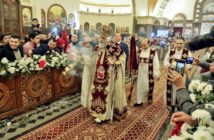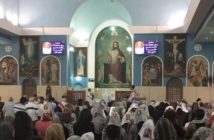Source: Frankly Speaking – OINOS Educational Consulting
Simon was an Egyptian shoemaker closely associated with the miraculous “movement” of the Mokattam Mountain in Cairo, during the Muslim rule of Caliph Al Muizz (953-975). According to Coptic ecclesial history, Al Muizz was an enlightened Caliph fond of inviting diverse religious leaders to debate pertinent issues. During one particular gathering, the Patriarch of the Coptic Orthodox Church in Alexandria was summoned to contest the identity of the true God.
As the Christian leader was gaining the upper hand in the debate, an exhausted opponent cited a New Testament verse that professed faith “as small as a mustard seed,” had the ability to “move mountains” (Mt 17:20). Recognizing an opportunity to embarrass a religious counterpart and possibly remove an obstacle that was spoiling his palace bedroom view, the Caliph quickly ordered the Patriarch to prove that Christianity was humanity’s rightful religion by commanding the Mokattam Mountain to change location.
After three days of vigilant prayer and fasting, the Orthodox prelate was instructed by the Virgin Mother in a dream to employ the ardent faith of a modest one-eyed cobbler to the Caliph’s challenge. According to historical record, a great earthquake swept over the region that day while the one-eyed Simon humbly prayed. In fact, the mountain lifted three times, exposing the dawning sun underneath it as it moved. As a result, a terrified Caliph embraced the Patriarch and declared a lasting friendship between their two religions. As a sign of his humble yet intense faith, Simon the Tanner disappeared never to be seen or heard from again.
Please click the following video link for a wonderful discussion of the Mokattam Miracle:https://www.youtube.com/watch?v=3W5Hqw2tRJM
Mountains play an important role in the Bible. While the ark of Noah rested on Ararat, the Mosaic Law was received on Sinai. The temple was built on Mount Zion and Elijah confronted the pagan prophets of Baal on Carmel. Like His glorious Transfiguration, Jesus ascended into heaven from a high summit. That these and other central scriptural events occurred on mountains indicates the importance that God consigns to high places!
Life is full of mountains. While some require climbing, others are best managed by circumvention. However, as mountains can also be viewed as life-defining litmus tests of conviction and authenticity, there are select crests that require moving. Herein lies the valuable lesson of the Mokattam miracle.
Moving mountains presupposes the “movement” of minds, hearts, and souls. Unfortunately, the acceptance of a mindset that emphasizes such strategic cultivation requires a paradigm shift in the way that many philanthropic, educational, and faith-based leaders envision the fidelities of their respective constituents. As more and more is expected of civic entities, donor relationships based on elementary communications and outdated media are no longer sufficient. If surmounting the mountains that obstruct an institution’s aspirations are indeed genuine, then a more robust management of tactical “moves” is required – one that cultivates trust, authenticity, and engagement prior to solicitation.
Originally developed by G.T Smith (1973), “moves management” is an intentional method for cultivating and nurturing relationships with and among constituencies and potential donors. It is essentially a development model for increasing institutional engagement. David Dunlop, the Cornell University senior development officer, described the idea as “changing people’s attitudes so they want to give.” As such, moves-based development is most concerned with donor sympathies and less with securing immediate financial commitments. Apart from Smith’s FIVE-I Model, numerous hybrids have been proposed (D. R. Dunlop, 1993; R. F. Prather, 1981; W. F. Dailey, 1986; E. W. Wood, 1989; E. R. Tempel, 1991; V. Steele & S. Elder, 1992).
Such a system of dynamic development must be envisioned as more than the routine solicitation of financial treasure. As important as fiscal vitality might at first appear, the lack of money is not the primary mountain negatively affecting most contribution-based institutions. On the contrary, when religious, nonprofit, and institutions of higher learning continually struggle with visible financial issues, it is usually an indicator that, hidden at the core, is a deficiency in relational currency.
Two dysfunctional fundraising approaches are frequently situated in the stewardship cultures of such organizations. While some over-indulge major donors by allowing their eccentricities to dictate the design of institutional aspirations, others, while less elitist, advance an ethos of solicitation characterized by the unhealthy hierarchical injunction of “father knows best.” By harnessing the balanced sensitivities of more thoughtful moves management, faltering organizations can more respectfully cultivate constituent relationships and thereby revitalize the resiliency of their development efforts.
In their 2008 study, Passing the Plate: Why American Christians Don’t Give Away More Money, Smith, Emerson, and Snell identify two primary cultural models currently used by philanthropic institutions for soliciting the support from constituents. While the first paradigm employs the tactics of resource scarcity to compel devotees to help “pay the bills,” the second, “living the vision,” advances a more participatory (donor-centric) culture that links institutional mission, creativity, and vision to the stewardship of time, talent, and financial support. In fact, according to theUnleashing Catholic Generosity Report (Starks & Smith, 2013) conducted by the University of Notre Dame, when “moves management” is used to cultivate a “living the vision” culture, faith and philanthropy-based institutions consistently report higher levels of donor support and financial sustainability.
Numerous Gallup investigations support the conclusions of Passing the Plate, and Unleashing Catholic Generosity. Relational vitality does enhance sustainability to the mission of philanthropic agencies! When religious, nonprofit, and institutions of higher learning utilize moves management for building and nurturing healthy relationships, not only do they avoid financial trouble, but, more importantly, the network of relationships actually becomes a platform for other essential cultural currencies such as volunteerism, collaboration, advocacy, and servant-leadership.
A comparison (Click Here) of the most common Moves Management approaches reveals five (5) important stages of cultivation, namely: (a) donor identification, (b) information, (c) interest, (d) involvement and (e) investment.
A “move” may be understood as the meaningful engagement of or interaction with a potential donor. Apart from utilizing an appropriate move-management process, civic, education, and faith-based entities wisely employ robust information databases systems such as Donor-Search and Raiser‘s Edge to support their relational networks. An organization implementing moves management should also have policies, procedures, and practices that direct the actions of the organization towards bringing in donors, forging relationships, and generating major gifts. These systems should all be focused on donors rather than donations.
OINOS Consulting has developed its own unique model that is based on: (a) empirical research data, and (b) the scriptural catalyst for the Mokattam miracle. The F.A.I.T.H. Moves Management Model encourages organizations to: (a) farm, (b) appraise, (c) integrate, (d) test, and (e) harvest the impact of current constituent relationships along the contribution – legacy gift continuum. In so doing, the F.A.I.T.H. paradigm nurtures an institutional culture of “living the vision,” rather than “paying the bills.”
F. A. I. T. H. MOVES MODEL
(Click Here)
| F | A | I | T | H |
| Farm | Appraise | Integrate | Test | Harvest |
|
|
|
|
|
Appraise
During the “appraisal” phase, meticulous research is conducted on the individual prospects identified and catalogued in the previous phase. Best practice research recommends the authorization of donor prospect committees that can regularly meet to surreptitiously discuss and appraise the capacity, affinity, and probability levels (major gift and legacy estate conferrals) of each potential benefactor.
According to E. W. Wood (1989), while organizations should allocate 85% of their development efforts for research, and cultivation, only 5% should be spent on actual solicitation. The remaining 10% should be used for donor recognition. In order to successfully “move” prospects along the FAITH continuum, soliciting entities should, therefore, strive to confidentially collect as much biographical information as possible.
Unfortunately, many leaders spend a disproportionate amount of time on solicitation and skimp on providing appropriate time and resources to conduct meaningful formative research. This omission contributes to untargeted solicitation and sloppy talent-based volunteer invitations. Alternatively, the appraisal phase should be used to develop individual profiles that identify: (a) current capacity, (b) relationships, (b) interests, (c) social circles, and (d) readiness levels of potential donors. Appropriate action plans can then be designed to nurture donor-institution relationships by encouraging integration.
Integrate
Donors choose to invest in an organization for a variety of reasons – passion for its stated mission/vision –of foremost importance for their giving. The U.S. Trust Study of High Net Worth Philanthropy (2014), concluded that wealthy donors “give more, are more impactful, and more personally fulfilled” when they are “intentional about and engaged in their giving,” and “find meaningful intersection between their ideas and ideals” and those of a soliciting organization.
Unsurprisingly, the Centre for Charitable Giving and Philanthropy (2010) likewise insists that people do not give because of “urgent need,” but rather “in support of causes that provide personal meaning and impact society.” It is, therefore, of great importance for development efforts to rouse a potential donor‘s interest by aligning their aspirations to an entity’s mission/vision.
Potential donors feel privileged to be integrated with a cause that is considered “greater” than self. Donors who are, therefore, sympathetic to an entity’s mission are more inclined to contribute to the advance of its vision. It is crucial to involve volunteers at this stage of “integration” in the moves management process, as the peer-to-peer relationship is one of the strongest methods for cultivating potential donors. An ancillary benefit to involving volunteers in this process is that their participation can serve as a means to further their own integration, thereby actually generating a “move” for them.
According to U.S. Trust Study of High Net Worth Philanthropy (2014), volunteerism has a strong connection to giving levels. On average, wealthy donors who volunteered in 2013 gave 73% more than those who did not volunteer ($76,572 compared to $44,137). The study also found that giving among wealthy donors who volunteered increased 23% in 2009 ($62,302) when compared to 2013 ($76,572). The research is clear. When constituents are aware, engaged, and integrated into the efforts, strategies, and plans of an institution, they are able to develop a more authentic relationship with it.
Test
The hypothesis that most Americans do not give generously due to suspicions of administrative waste and abuse is true! The only way to combat this perception and enjoy the harvest of meaningful engagement is to cultivate financial transparency and provide donors with authentic opportunities for “testing” an organization’s integrity.
Research overwhelmingly supports the notion that potential donors require proof and confirmation that their loyal stewardship of time, talent, and/or financial treasure is: (a) appreciated, (b) appropriately deployed, (c) utilized to advance a specified mission/vision, and (d) highly impactful. The current trend is, therefore, away from impulse/emotional giving and towards unhurried, meditative-based donations to organizations that donors have tested and found worthy of continued loyalties.
Donor loyalty should here be understood as the level of trustworthiness that an organization expresses to its donors, and not the other way around. Contribution-based entities that are “donor-centric,” therefore, are more apt to build trust in three vital areas: (a) mission/vision authenticity, (b) gift/donation integrity, and (d) operational efficiently. Sadly, many civic, education, and faith-based organizations do not focus adequate attention on these fundamental indicators of good management and, as a consequence, it dramatically affects positive donor retention.
Savvy stewards, value and expect that the organizations they choose to support carefully manage their gifts and demonstrate that they are making a meaningful difference through the wise and transparent use of solicited resources. Along with the guidance of strong leadership and confidence in the mission-based management, an authentic testing-phase is key to the development of trust, commitment, and the reception of major gifts.
Harvest
The final stage of the cyclical FAITH Moves Management Model is the “harvesting” of relational currencies. When the previous steps have been appropriately executed, soliciting organizations will “harvest” a number of valuable exchanges, foremost of which is the currency of authentic engagement. The transition from testing to harvesting is crucial for such “investments” to occur along the cultivation pathway.
The currency of relationship is the internal and external network of mutually respectful engagements that constituencies share. While internal engagements include constructive relationships among donors, affiliates, and other intra-organizational structures, external engagements include constructive relationships with potential donors, the larger civic and business community and recipients. By periodically assessing these internal/external connections, organizations can strengthen fragile associations and thereby more fully harvest the benefits of relational currency.
The movement of the Mokattam Mountain was triggered by much more than the ardent stewardship of one modest tanner. The miracle was triggered by the collective faith of a fully engaged 10th century religious community whose spiritual leader was unafraid to grapple and rejoin the dangerous issues of his day. As a result of the hamlet’s three-day commitment of time (vigil/prayer/fasting), obedience (adherence to Divine instruction), and humility (seeking the assistance of simple shoemaker), the mind, heart, and soul of a more powerful Caliph was “moved.”
Historical narratives indicate that shortly after the miracle of Mokattam, Al-Muizz converted to Christianity! The Caliph abdicated his influential throne in favor of his son and spent the rest of his life in a monastery. Although many Muslim historians reject the account, a baptismal font known as “Maamoudiat Al-Sultan” or the “baptistery of the Sultan” still exists at the location of Al-Muizz’s conversion.
Astoundingly, as a gesture of his newfound Faith, the Caliph offered to provide a substantial monetary gift to the Coptic Patriarchate for the reconstruction of its regional churches. The patriarch, however, was uninterested. “He, who’s Church we are building,” insisted the hierarch “does not need the money of this world.”
The Miracle of Mokattam is a legacy gift – a “harvest”– that contemporary donors can only dream of endorsing! If philanthropies, institutions of higher learning, and faith-based entities honestly aspire to move the mountains that block the vision of their respective goals they must then commit themselves to more moves-based stewardship of their relational currencies. Only by engaging the modest, yet ardent, faith of constituents like Simon the Tanner whose minds and souls have already been “moved” by the reveries of their mission, can the leaders of such organizations hope to develop the aptitude to reduce societal marginalization, ignorance, and iniquity.
In the end, while fiscal capacity is important, only Faith can move mountains!



